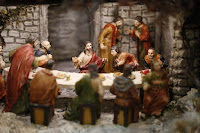I came across an article by The Gospel Coalition (TGC) this morning called "9 Things You Should Know about Jewish High Holy Days." And it was insightful as it explained some of the traditions in Judaism surrounding the feast days known as Yom Teruah (Day of Shouting/Trumpet blowing), or more commonly known today as Rosh Hashana (Jewish New Year), and The Day of Atonement. The article's author includes things such as the period of repentance, the etymology of holiday, and the extent of fasting on Yom Kippur.
But alongside my sense of interest was also a sense of disappointment. These two festivals that were given by God and recorded in scripture were treated by the author as nothing more than cultural phenomena. Instead of a theological or exegetical treatise, which is more of what I expect from TGC, the article read more like an anthropological paper. Now, the title did say 'Jewish' High Holy Days, and the title High Holy days is a cultural invention, so the title does lend itself to cultural focus. Nonetheless, these days are rooted in scripture as part of God's redemptive story leading to Christ, and for a reformed/Calvinist organisation like TGC to ignore this is surprising. But perhaps by keeping the High Holy Days at arms length, they don't have to consider any potential relevance to Christians today as well as retaining the feast days' supposed Jewish label.
Thus, the modality of the article's title is off. How Jews celebrate the High Holy Days: nice to know. How the High Holy Days reveal God's redemptive plan: what Christians should know.
So allow me to provide 9 meaningful things you should know about the High Holy Days:
So allow me to provide 9 meaningful things you should know about the High Holy Days:
When God gave the feast days in Leviticus 23, He said:
"Speak to the people of Israel and say to them, These are the appointed feasts of the Lord that you shall proclaim as holy convocations; they are my appointed feasts.” (Lev 23:2-3)
He didn't say:
“Speak to the people of Israel and say to them, These are the appointed feasts of the Jews that you shall proclaim as Jewish convocations; they are the Jews appointed feasts.”
So to label the High Holy Days, or any other feast day as Jewish is not biblical. Since they are God's feasts, we cannot attribute them to the Jews only since the Lord is God over all people (Rom 3:29), thus His feast days are for all people too. Moreover, when God gave the Law, which includes the feast days, He said that it applies to the stranger (Gentile) who resides among them who wants to worship God in an equal manner as the native Israelite. In fact there are times in the Prophets when God invites Gentiles to celebrate them (Isa 56:6, 66:23; Zech 14:16).
2. They reveal the holiness of God.
That they are the feasts of a Holy God, it's no surprise that they should include a holy convocation and a day of rest, as is reflected in the holiness of the Sabbath that was established in Genesis 2:1-3. More specifically, as the High Holy Days, they are a time to reflect on whether the Holy Nation of a Holy God are walking in His ways.
That they are the feasts of a Holy God, it's no surprise that they should include a holy convocation and a day of rest, as is reflected in the holiness of the Sabbath that was established in Genesis 2:1-3. More specifically, as the High Holy Days, they are a time to reflect on whether the Holy Nation of a Holy God are walking in His ways.
3. They reveal the importance for God's people to remember.
The first of the High Holy Days is not actually given a name in scripture. Rather, it is simply described as a memorial. Later developments in the Bible, especially the Psalms, reveal that it is a day to remember that God is King. Flowing from His role as King, the one whose job it is to execute justice, the Day of Atonement reminds people of the need to walk in his ways and be in right standing with Him. Although these are to be remembered daily, an annual time for deep specific reflection shows that God wants to ensure His people remember.
4. They reveal the need for atonement.
Yom Kippur was given as a day for national atonement and cleansing of the Most Holy Place for the sins of Israel not covered by the daily sacrifices. For a Holy God to dwell among sinful people, sin needs to be atoned for.
5. They reveal the need for repentance.
The ritual of Yom Kippur was able to cleanse the Most Holy Place, however the ceremony did nothing for individuals' relationship with God. This is why on the day of Yom Kippur, individuals would participate and connect themselves with the cultic work of the High Priest by being in prayer and repentance for their sins. Over time after the destruction of the Temple, the time between the two feast days evolved into the 10 Days of Awe as the people prepared themselves for the day.
6. They foreshadow the priesthood of Christ.
The book of Hebrews spends much time connecting the sacrifices on The Day of Atonement with that of Jesus' sacrifice. One way that it does this is by showing the imperfect/sinful nature of the High Priest who was unable to completely atone for the sins of the people. Thus the original Day of Atonement was looking forward to a perfect priest who could perfectly atone for the people's sin.
7. They foreshadow the work of Christ.
The Day of Atonement sacrifices were able to cleanse the sins from the Holy Place, which is a shadow of the true Holy Place, but unable to cleanse the sins from people's consciences. Moreover, the sacrifice needed to be repeated every year. But, as the author of Hebrews explains, the work of Christ on the cross was a once for all sacrifice that was able to be applied in the true Most Holy Place. Thus the sacrifices of the Day of Atonement were looking forward to a time when people's sins would be thoroughly atoned for.
8. They foreshadow the return of Christ.
As well as pointing to the person and work of Christ, the feast days, which include the Day of Memorial and Day of Atonement, are a shadow of "things to come" (Col 2:17) which shows that they foreshadow the events of the last days, often referred to by theologians as the eschaton. The Day of Memorial which involves the blowing of a trumpet points us to the return of Christ. Specifically, Matthew 24, 1 Corinthians 15, and 1 Thessalonians 4 describe the descent of Christ and the resurrection as being preceded by a trumpet blast.
9. They foreshadow the final judgement.
The Day of Atonement, which reveals the need for forgiveness of sins, points us to the day of judgement when the atoning work of Christ will come into full effect as those who have put their faith in Christ are declared righteous and spared from the wrath of God.
Reuven Hammer, Entering the High Holy Days: A Complete Guide to the History, Prayers and Themes. JPS: Philadelphia. 2005.
Image: http://www.ruachisrael.com/shabbat-holy-days/holy-days/
So as we have seen, these two feast days are not simply cultural phenomena, although a number of cultural traditions have been added to them. As with the other feast days of the Lord, they are reminders of the character and purposes of God that reveal His plan of salvation through our Messiah, Jesus.
References
Joe Carter, "9 Things You Should Know About Jewish High Holy Days", The Gospel Coalition, 26 Sept 2017, www.thegospelcoalition.org/article/9-things-you-should-know-about-jewish-high-holy-days.Reuven Hammer, Entering the High Holy Days: A Complete Guide to the History, Prayers and Themes. JPS: Philadelphia. 2005.
Image: http://www.ruachisrael.com/shabbat-holy-days/holy-days/





